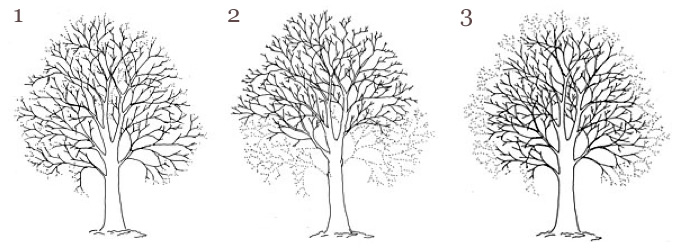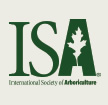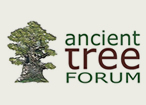Below are the four main pruning explanations that we generally use in describing our pruning specifications, additionally, you may find the following terms helpful.
It should be noted that many trees are legally protected. Removing or even just pruning a protected tree without Local Authority consent may be a criminal offence. See our Trees & the Law page
The Main Pruning Definitions
1. Crown Thin
Crown thinning is the removal of a small percentage of secondary and small live branches to produce a uniform density of foliage around an evenly spaced branch structure. It is usually confined to broad-leaves species. Crown thinning includes crown cleaning and does not alter the overall size or shape of the tree. Common reasons for crown thinning are to allow more light to pass through the tree, reduce wind resistance or to lessen the weight of heavy branches.
2. Crown Lift (or Crown Raise)
Crown lifting is the removal of the lowest branches and preparing of lower branches for future removal. Good practice dictates crown lifting should not normally include the removal of large branches growing directly from the trunk as this causes large wounds which may jeopardise the long term future of the tree. Common reasons for crown lifting are to bring more light and give access for traffic. In the UK common practice dictates clearance for vehicles is 5.2 metres (17 feet), and for pedestrians 2.5 m (8 feet).
3. Crown Reduction
Crown reduction is used to reduce the height and/or spread of the crown of a tree by the removal of the ends of branches whilst maintaining the tree's natural shape as far as practicable.

4. Crown Clean
The removal of overcrowded, dead, diseased, broken, weakly attached and low-vigour branches and can include climbing plants such as Ivy
THE BRITISH STANDARDS MOST RELEVANT TO ARBORICULTURAL WORK ARE BS 3998 RECOMMENDATIONS FOR TREE WORK AND BS 5837:2005 TREES IN RELATION TO CONSTRUCTION RECOMMENDATIONS.
Other useful terms associated with tree work
Bracing
Bracing is a term used to describe the strengthening or supporting of a tree by means of cables, rods, webbing or similar.
Callus
Scar tissue laid down by the tree in order to cover and protect a wound, e.g. a pruning wound.
Co-dominant or forked growth of stems
The development of two or more leading shoots of roughly equal size and vigour competing with each other for dominance.
Conservation Area
The designation given to an area by a Local Planning Authority (LPA) which requires, amongst other things, six weeks advance notice to be given to the LPA prior to certain tree works. In other words, most works to most trees within a Conservation Area must not be undertaken without notifying the LPA in writing six weeks in advance. Failure to do so may be a criminal offence. See our Trees & the Law page
Coppicing
The cutting down of a tree within 300 mm (12 in) of the ground at regular intervals (typically on a one to five year rotation). Traditionally applied to certain species such as Hazel and Sweet Chestnut to provide stakes etc.
Crown
The section of the tree formed by its branches and usually starting above its stem.
Dead, Dying Dangerous or a Nuisance
The catch-all phrase describing the conditions of trees to which protection afforded by Tree Preservation Orders or Conservation Areas does not apply. Legal definitions are the subject of much debate, often through the courts and professional advice is strongly recommended.
Decline
When a tree exhibits signs of a lack of vigour and progressing towards its death.
Dieback
Tips of branches exhibit no signs of life. As decline progresses so more branches are affected and to a greater extent.
Drop Crotching
Shortening branches by pruning off the end back to a lateral branch which is at least 1/3 diameter of the removed branch.
Formative pruning
Pruning during the early years of a tree's growth to establish the desired form and/or correct defects or weaknesses.
Fungi/Fruiting bodies
Any spore-bearing structure on a stalk (like a toadstool) or attached directly to the tree (a 'bracket' fungus). Note: some are harmful (cause disease - pathogenic), some are harmless (living on material already dead - saprophytic) and some are beneficial (symbiotic).
Pathogenic
This usually refers to fungus that is capable of causing disease or infection
Pollard
A commonly used this term describes the removal of all branches from the trunk. Mature trees that have not been previously pollarded are generally not suitable for pollarding due to the large subsequent wounds such treatment produces. Furthermore, the long term integrity of the tree will undoubtedly be undermined. A pollarded tree usually requires regular pruning of re-growth.
Tree Preservation Order (TPO)
Statutory protection applied to a tree or trees meaning that most works to most trees covered by a TPO must not be undertaken without the prior written consent of the LA. Failure to do so may be a criminal offence.
See our Trees & the Law page
Pruning
The importance of the pruning cut
Every pruning cut inflicts a wound on the tree. The ability of a tree to withstand a wound and maintain healthy growth is greatly affected by the pruning cut - its angle and its position relative to the certain parts of the tree. As a general rule branches should be removed at their point of attachment or shortened to a lateral which is at 1/3 of the diameter of the removed branch.
When to prune
As a general rule pruning should be avoided in the Spring and the Autumn. Outside these periods most trees can be pruned at any time of the year, with a few exceptions such as Cherry, Plum and related trees which should be pruned soon after flowering to reduce the risk of bacterial infection. Maple, Birch, Beech and Walnut should be pruned in leaf or just after leaf fall and Magnolia in high summer to avoid 'bleeding' (exuding sap), which although not considered damaging, can be unsightly.











